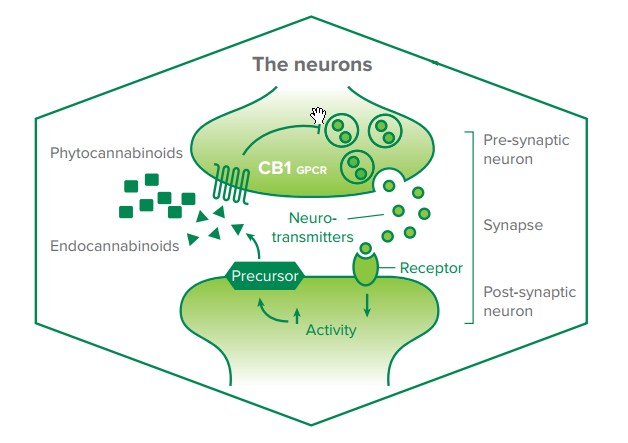Endocannabinoids and the endocannabinoid system
The endocannabinoid system is an intercellular neurotransmitter system that extends beyond the brain and is found in other organs and tissues of the body. It is related to the ancestral arachidonic acid-based intercellular communication system, which is also found in plants, and is believed to be an evolved version of this system.
What are cannabinoids?
To explain what endocannabinoids are, it is necessary to know their external counterparts, the cannabinoids. Cannabinoids are organic compounds belonging to the terpenophenol group, which bind to cannabinoid receptors in the human body. There are three types of cannabinoids: phytocannabinoids synthesized by the cannabis plant; endogenous cannabinoids, produced by animal organisms and the human body (e.g., anandamides); and synthetic cannabinoids or neocannabinoids, similar compounds generated in the laboratory. Delta-9-tetrahydrocannabinol (∆9-THC, or THC) is one of the best-known cannabinoids, and is the primary psychoactive ingredient in marijuana. We understand endocannabinoids, as its prefix suggests, as any cannabinoid produced by our body.
The endocannabinoid system
The way in which endocannabinoids and cannabinoids relate to our organism is explained through the endocannabinoid system. It consists of a model of neurotransmission that the cells of our body use to send information to each other about a wide variety of sensations. These range from appetite to pain or anxiety, although it is also responsible for interpreting the psychoactive effects of cannabis. Two elements are involved in this system: Endocannabinoids and their receptors.

Endocannabinoids are transmitters of physiological information that activate their receptors triggering different metabolic processes at the neuronal, digestive, reproductive and immunological levels. To give us an idea, they act as keys that open certain locks. These locks would be the endocannabinoid receptors, which are located in the different cells of our organism. When these two elements come into contact with each other, different metabolic processes are triggered at the neuronal, digestive, reproductive and immunological levels. This makes it a deeply necessary system for the development of the vital functions of the human being.
A bit of history
To understand the discovery of this “supercomputer that regulates homeostasis in the human body” we must go back to the 1960s, when the chemist Raphael Mechoulan began to study the active principles of Cannabis Sativa. In this way, he was able to isolate some of the best known cannabinoids, such as Tetrahydrocannabinol (THC) and Cannabidiol (CBD). From the study of the reaction of the first of these compounds with the body, carried out by the researcher Allyn Howlett, it was discovered that in our organism there was an endocannabidol receptor in which THC fitted perfectly. This receptor received the name of CB1 and was a revolutionary discovery, since it makes us understand how certain elements present in Cannabis fit perfectly with our biology.
Professor Mechoulan took over from these discoveries. Thus, in 1992, thanks to his knowledge of THC, he discovered an endocannabinoid that perfectly matched the receptor discovered by Howlett, which he named Amandine, Sanskrit for “supreme joy”, consisting of a substance produced by our body that emulates THC. Here, not only did it become evident that an endogenous intercellular information system capable of regulating physiological features of our body as diverse as appetite or movement was functioning, but also that it functioned in a similar way as certain compounds of Cannabis Sativa do in our organism.
Endocannabinoid classes and therapeutic uses
As Mechoulan himself acknowledges, “The endocannabic system is very important. Almost every disease we have is related to it in some way”. And this means that the human being needs a balance in the levels of Anandin and 2-araquinodilglycerol (another endocannabinoid discovered later) to maintain its vital functions in a stable way. In such a way that, when these compounds become unbalanced in our organism, what we would interpret as a malaise, they can be corrected by the use of cannabinoids such as THC and Cannabidiol, bringing the patient back to a stable and healthy point.
Also, as with cannabinoids, the entourage effect plays a very important role in endocannabinoids. We recommend you to read our article about it: Entourage Effect.
If on the one hand we understand that Anandamide is an organic chemical compound generated by our body that mimics the effects of THC, we can understand that our body produces substances present in Cannabis, and hence establish the syllogism that Cannabis is in our body immanently. So its therapeutic use is presented as something reasonable.

As we mentioned before, there is another type of endocannabinol, 2-araquinodilglycerol. This, like Anandamide, plays a fundamental role in controlling the endocrine system of living beings. This molecule is being studied for the treatment of obesity by reducing the number of calories ingested by animals.
If you wanted to know more about the different types of plants, How to differentiate between female and male marijuana? and Male Cannabis, What is it and How is it Grown?
Note: Experiencia Natural advocates a responsible consumption of mariihuana and reminds that it is a subjective experience. This article has been documented with medical sources duly cited and written based on documentation reflected in studies. However, we are not medical practitioners and recommend consulting a medical professional before deciding to apply cannabis consumption to any treatment.













